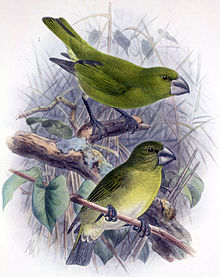Kona grosbeak
| Kona grosbeak | |
|---|---|
 |
|
| Adult (above) and immature (below) Bill color was actually more pinkish, as in the image below. |
|
| Scientific classification | |
| Kingdom: | Animalia |
| Phylum: | Chordata |
| Class: | Aves |
| Order: | Passeriformes |
| Family: | Fringillidae |
| Subfamily: | Carduelinae |
| Tribe: | Psittirostrini |
| Genus: | † Chloridops |
| Species: | † C. kona |
| Binomial name | |
|
Chloridops kona (S.B.Wilson, 1888) |
|
| Synonyms | |
|
Psittirostra kona (Wilson, 1888) |
|
Psittirostra kona (Wilson, 1888)
The Kona grosbeak (Chloridops kona) is an extinct species of Hawaiian honeycreeper. The Kona grosbeak was endemic to naio (Myoporum sandwicense) forests on ʻaʻā lava flows at elevations of 1,400–1,500 metres (4,600–4,900 ft) near the Kona District on the island of Hawaii. The species was already very rare when it was first discovered, being found in only about 10 square kilometres (3.9 sq mi), and was last collected in 1894. Reasons for its extinction are not very well known. The genus is known from fossils from Kauai, Oahu and Maui. It was unknown to the Native Hawaiians, and thus a name for it does not exist in the Hawaiian language.
The Kona grosbeak, at 15 centimetres (5.9 in), was a medium-sized, chunky bird. Its plumage was a dull olive green, and did not display sexual dimorphism. The bird had a large head and a giant, brownish-gray beak.
The Kona grosbeak was a frugivore, with a large beak adapted to break through the hard endocarp of dried naio (Myoporum sandwicense) fruits. It may have also taken green naio fruit and leaves, as well as softer fruit such as that of the ʻieʻie (Freycinetia arborea). Young were most likely fed invertebrates.
The ornithologist Scott Barchard Wilson was one of the few people to observe Kona grosbeaks in the wild. An account of his sightings is featured in The Ibis, which was published in 1893:
...
Wikipedia

